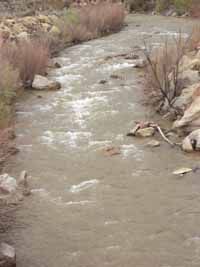| The Price River is under study by the BLM in conjunction with federal legislation enacted in 1968 . Wild and scenic river proponents claim the designations have little effect on past practices. But opponents contend that a great deal can change, including the way private land around the classified streams can be used. |
In 1968, the United States Congress passed the Wild and Scenic Rivers Act.
The federal legislation specifically named a number of rivers in the U.S. However, the act was passed to apply to additional waterways in the future and that has been happening.
During the years since 1968, federal agencies have been working on classifying more and more rivers as wild, scenic or recreational. Under the law, the designation is based on current use and rivers possessing “remarkable scenic, recreational, geologic, fish and wildlife, historic, cultural” or similar values. The original idea was to protect the rivers for future generations.
But in the early stages of the law’s implementation, funding was cut and the process slowed considerably.
The act recognizes three types of rivers for protection – wild, scenic and recreational. All three are protected from impoundment or water development that would harm the rivers’ free-flowing character. The distinction stems from the level of development that can be allowed along the river corridor.
Wild rivers are the most pristine, generally accessible only by trail, and have undeveloped shorelines.
Scenic rivers have shorelines that are largely undeveloped, but may have some access by roads.
Recreational rivers have more shoreline development and are easily accessible by road.
Presently, the U.S. Bureau of Land Management recently started to study and classify rivers and drainages in the Carbon-Emery County areas. Because of the federal agency’s activity, Carbon commissioners selected county building official Dave Levanger and Rex Sacco from the Geographic Information Systems department as contact people on the wild and scenic rivers designation program being processed by the BLM.
The process leading to one of the three designations begins with an eligibility and classification stage. The Price River, some of its tributaries and other waterways in the local area are presently under the initial stage of the project. The two final phases include suitability and dedication of the streams to a category.
Based on a meeting and contacts with the BLM, Levanger and Sacco introduced a proposed resolution to the Carbon County Commission on Oct. 2 for adoption. The resolution specified that there should be no net loss of private ownership in acreage, volume of water or acreage.
“I am concerned about what can happen here, that is the reason for us proposing the resolution,” explained Sacco. “I am worried about how the rivers and streams will be classified. It could restrict use of the property by owners and it could also affect the water rights and the amount of water available. It could also create property tax problems.”
The commissioners talked about the situation and discussed the ramifications of the proposed resolution.
“I think we need to go ahead with this before it is too late,” indicated Commissioner Mike Milovich. “I worry about use and about how the federal government could take water or land without renumeration.”
Commissioner Tom Matthews concurred with Milovich, stating that he thought approving the resolution would be an appropriate action for the county to take.
But Commissioner Bill Krompel raised several concerns regarding the matter.
“I think we need more time to talk this over and examine it,” commented Krompel. “I worry the way it is worded that it may restrict a private owners right to sell his property to another owner or even to the state or federal government.”
The discussion continued, with several parties in attendance at the commission meeting feeling the proposed resolution would not restrict a property owner’s right to sell and other people worried that adopting the guideline would.
In addition, the possibility of land along a river receiving scenic designation becoming so restricted in use that the private property would be virtually worthless to the owner.
“Severe restrictions of use would basically be the same as taking the land from an owner,” pointed out Carbon County Attorney Gene Strate.
Krompel maintained that the proposed guideline needed to contain language designed to prevent the resolution from affecting people’s ability to sell private property.
The concerns of local citizens and officials regarding land along a river receiving federal designations is nothing new. For years, many areas across the nation have been struggling with situations that have arisen from rivers being designated.
Supporters of the federal designations – like American Rivers – claim many concerns people voice, including perceived threats to private land ownership and implementing extremely narrow restrictions on activities permitted in selected areas, are not true.
The group’s members bill the organization as a “community of river activists and friends.”
Similar statements fall within the range of comments made by most environmental groups about the act.
But detractorscontend that rivers that are designated often do not fit the definition of the law, including “free flowing” or “unimpacted.” Proponents also point out that the use along a river, often taking place for generations, can be curtailed by the designations.
But one main concern involved in western opposition to the act has less to do with the land than with the water and water rights. Opponents fear that the law is being used by the federal government to attack the states’ ownership of water.
The county commission decided to table the resolution until the lawmakers could research potential impacts as well as the wording contained in the document.

